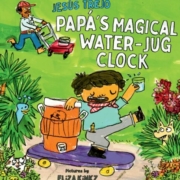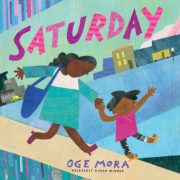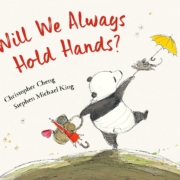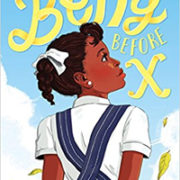“Elbert in the Air” and “Babble!”
I want to share about two of my favorite new titles in the Children’s Department. The first is the picture book Elbert in the Air by Monica Wesolowska with illustrations by Jerome Pumphrey. I am not sure what I loved more about this book–the breezy, old-fashioned illustrations or the heartwarming story of acceptance and self-love. Elbert’s story begins with the line, “Shortly after he was born, Elbert floated into the air.” This simple line sets the tone and plot of the story very effectively. The text on the first page is accompanied by a happy looking Elbert reaching out to his surprised mother whose arms are also outstretched as if to catch him. As people are wont to do to a new mother, neighbors gather around to offer advice; in this case, the advice consists of methods of catching or containing Elbert. Elbert’s mother simply responds with “If Elbert was born to float, I will let him.” The story carries on in much the same manner, with Elbert floating higher and higher as townspeople offer more and more well-meaning but unhelpful pieces of advice.
Once he is old enough to go to school, Elbert becomes very aware of the fact that he’s different. Throughout the story, his mother continues to vocally support and love him for who he is. She never tries to change him and he does eventually find his people. This is the type of parent I hope to be as my child grows up (though he has not shown any signs of floating–yet!). It feels hopeful to read about a child perceived as different who finds happiness and self-acceptance in a community of their peers. While it would have been a perfectly nice story if it ended with the townspeople accepting Elbert rather than trying to fix him, the actual ending was that much better. There is joy in finding people who are like you, people to whom you don’t need to explain yourself.
I love this book for its illustrations as well. They feel very old-fashioned, reminiscent of the aesthetic and style of the 1950s. Pumphrey paints primarily in soft reds, yellows, blues and greens, with simple, black-lined facial expressions. Though the illustrations are simple, they don’t minimize the story in any way. In fact, they seem to enhance it, giving soft edges to an emotional story.
The second book I would like to share is Caroline Adderson’s Babble! And How Punctuation Saved It. Admittedly, I am a bit of a grammar nerd, but this punctuation parable would be a fun read for anyone. It tells the story of an unnamed stranger who arrives in town with an odd gift– a period. By the time the reader gets to this event, they will likely be begging for it to be inserted into the story. The first several pages are to be read as one long, meandering sentence because, as you will discover, you can’t stop reading unless there is a logical place to do so. Hence, the glorious period. The townspeople are confused at first, though they quickly come to feel grateful for the humble period, the question mark, quotation marks, and exclamation points. They can communicate emotion! They can tell stories! They can take turns talking while doing so!
Adderson brings grammar to life and Roman Muradov’s simple black line drawings, filled in with light reds, add a cartoon strip-like feel that highlights the story’s levity. This treatise on the power of punctuation concludes with an important (though not pedantic) message about listening to and really understanding one another. Babble would be a delightful read aloud for elementary students learning about punctuation or listening skills. It also feels similar in style to B.J. Novak’s The Book With No Pictures, which is beloved by early elementary-aged readers.










